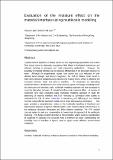Evaluation of the Moisture Effect on the Material Interface Using Multiscale Modeling
Author(s)
Qin, Renyuan; Lau, Denvid
Download42493_2018_8_ReferencePDF.pdf (715.9Kb)
Publisher Policy
Publisher Policy
Article is made available in accordance with the publisher's policy and may be subject to US copyright law. Please refer to the publisher's site for terms of use.
Terms of use
Metadata
Show full item recordAbstract
Abstract
Layered material systems are widely seen in various engineering applications such as thin films circuit boards in electronic engineering, lipid bilayer in biological engineering, and adhesive bonding in aerospace and civil engineering applications. However, the durability of the material interface can be seriously affected due to the prolonged exposure to water. Although the experimental studies have shown the reduction in terms of ultimate bond strength and fracture toughness for material interface, the shift in failure mode found in experiment cannot be explained using conventional fracture theory, which is related to the interaction between the water and material interface. To understand the debonding mechanism from a fundamental and comprehensive aspect and bridge knowledge from the atomistic scale to continuum scale, multiscale modeling approach has been proposed to study the debonding behavior of material interface under moisture effect. A number of studies have been conducted using multiscale modeling approach to investigate the debonding of material interface, and it is necessary to summarize these studies to understand the role of water molecules in weakening and diffusing at the material interface using different atomistic models, force fields and upscaling techniques. This paper provides a comprehensive review on the multiscale modeling of interfacial and delamination behavior of layered material system under moisture attack with the focus on the molecular dynamics simulation and finite element modeling. The FRP bonded concrete system is used as a representative to demonstrate the approach of multiscale modeling. The future research direction is recommended, which involves the consideration of roughness of substrate and structural voids at interface for the better understanding of durability issue for interface in layered material system under different environmental conditions.
Date issued
2019-03-18Department
Massachusetts Institute of Technology. Department of Civil and Environmental EngineeringPublisher
Springer Singapore